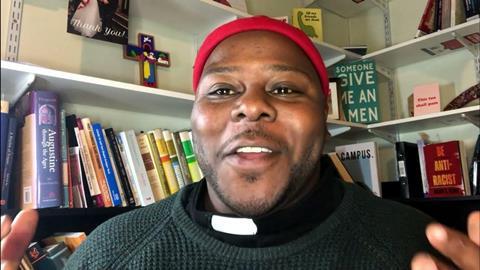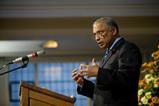It’s three years since the Church of England pledged a sweeping programme of reform to overturn racist culture in the Church. Following Racial Justice Sunday, Tim Wyatt asks what progress has been made

In the febrile atmosphere of 2020, as the world was locking down to save itself from Covid catastrophe, the murder of George Floyd sparked an international reckoning with racism. And just like countless other institutions, the Church of England also began to wrestle with its own record on inclusion and diversity.
Even before the pandemic and Black Lives Matter, months before any bishops were pictured taking the knee or a statue of the prominent Anglican slave-trader Edward Colston had been hurled into Bristol harbour, the Windrush scandal had already prompted the Archbishop of Canterbury to declare in February that the church he led was “institutionally racist”. Into this potent mix, two explosive cases of racism emerged almost as if to prove his point.
First, was the tale of Rev Augustine Tanner-Ihm. American by birth, Tanner-Ihm had felt a call to serve God in England during a ministry trip and by 2020 had almost completed his three years of training to become a vicar. But when he applied for a curacy post in Hertfordshire a local diocesan official shut down the negotiations on the grounds that the parish was a “monochrome white working class” community which could make the black priest “feel uncomfortable”.
“I was very, very upset – this was just blatant,” Tanner-Ihm recalled. He sat on the hurtful letter for months, but finally posted about it on Twitter later that summer when prominent C of E figures were throwing their weight behind Black Lives Matter. “I was just like, come on. This is crap. This is all for show.”
Since his story made headlines, Tanner-Ihm said he had been inundated by stories from other vicars who had suffered similarly. However, few of them would speak out publicly for fear of hampering their chances of promotion or sullying the Church’s reputation, which meant the scale of the problem was hidden. “We say often in the Church of England about ‘playing the game’,” he said. “I don’t believe in playing the game, I believe in advancing the kingdom of God.”
Several years earlier, another ethnic minority trainee vicar had been applying for positions. To try and get prepared ahead of one interview, Rev Alwyn Pereira requested a copy of his church personnel file. But in it he stumbled across emails from his then bishop to other senior diocesan employees. After wrongly identifying him as of Sri Lankan descent (he was actually born in Kenya to Indian parents), the bishop wrote Pereira was on his last chance after several failed attempts to find a vicar post. But it was the final remark which took Pereira’s breath away: “Having worked very closely with people from the Indian sub-continent in my past, I think there are cultural differences in the way people like Alwyn communicate and actually handle issues of truth and clarity.”
“I didn’t know what to do with it,” Pereira recalled. “I was thinking, is that racist?” Presuming he had done something wrong to provoke this, the priest began to own the idea he did lack integrity. “I was feeling so low, and deeply hurt and wounded that that was the perception.” He requested the rest of the diocese’s data on him and found more emails from further back where the same bishop suggested his previous applications had been resisted on “on the grounds of cultural eccentricities”, but noted this did create a perception of racial discrimination.
Increasingly angered by the discovery his own bishops had stymieing his career for seemingly racist reasons, Pereira began a lengthy attempt to seek redress in the courts. His case before an employment tribunal was eventually dismissed, but news of it did not break until the fateful summer of 2020.
All of a sudden, the CofE was reeling. In the space of just a few months, two serious cases of overt racism against its own clergy had arisen just as it had begun to account for historic failings. The spectre of racial injustice seemed to haunt the institution wherever you looked. Was the Church of England just as hostile an environment to people of colour as every other part of England seemed to be?
Racism is not a stain that can be washed away. It is a gaping wound in the body of Christ
Both Tanner-Ihm and Pereira said they had seen everyday low-level discrimination and prejudice throughout their ministries. “I still see it everyday,” Tanner-Ihm remarked. He regularly is stopped by security guards while going into church buildings and asked what he is doing there, most recently at a Manchester Cathedral service last year despite him wearing his clerical collar and robes. Often his white colleagues do not believe his stories until they see it for themselves.
Pereira likewise had plenty of stories to tell. At his own selection panel to be approved to train for the ministry, he was asked why he was seeking ordination: “It’s the Church of England, not the Church of Asia,” one interviewer told him. “Why do you want to be in the Church of England, because you’re not English?” Later in the same interview he was asked why he hadn’t pursued a career selling mobile phones given “your people” are good at tech. He has also been casually called “boy” or “Gunga Din” (an Asian character from a Rudyard Kipling story) by people in a previous church congregation.
The Bishop of Leicester Martyn Snow, who sits on the CofE’s Committee for Minority Ethnic Anglican Concerns, said he had been “frankly, shocked” to hear about some of the experiences clergy in his diocese had endured. “The stories people were telling were on occasions, yes, blatant racism, on occasions what’s often referred to as microaggressions, throwaway comments which can cause real pain.”
Brunel James, a cleric who works in the Church’s Racial Justice department said while the claims of “institutional racism” were accurate, in the end “who is the institution? It’s just an aggregation of all these Anglicans up and down the country”. Including, for instance, funeral directors who don’t ask the local black parish priest to conduct a funeral for a white family because they worry “that’s not what they’re expecting”.
The same point is made by Elizabeth Henry, who resigned from her role as the CofE’s national advisor on race and ethnicity in 2020. Acknowledging institutional racism was easy, almost a badge of pride, at this point, she said; it only addressed policies and procedures – but not people. Yet it was people not processes which perpetrated racism against ethnic minority Christians, and no-one ever wanted to accept they personally were racist.
Others pointed to deeper currents within the meaning of Anglicanism which made it difficult for people of colour to thrive within the C of E. Bishop Snow said the church had been quite “assimilationist”, meaning before joining the church “you have to become like us”. This forced people from diverse backgrounds to leave their own culture at the door. The historic links between the C of E and colonialism and slavery also come up again and again. The Church’s first Racial Justice Director, Guy Hewitt argued that being an established Church meant the C of E was, unlike other denominations, closely tied to Englishness and the conservatism of the state, making it difficult to expand the boundaries of what it means to be Anglican to include many of those who make up modern Britain.
From Lament to Action
In the wake of Black Lives Matter and cases such as those of Tanner-Ihm and Pereira, the C of E established a task force to urgently examine its record on racism. This produced a report, From Lament to Action, published in 2021, which urged a sweeping programme of reform to overturn racist culture in the Church. The report looked back at 40 years of discussion about race in the Church, and identified a staggering 25 different reports going back to the 1980s, featuring a total of 160 recommendations. And yet despite all these mountains of paper, black and brown Christians were still enduring discrimination and prejudice and there were no more ethnic minority bishops than there were in the mid-90s.
Much like with safeguarding, for decades racial justice had not been taken seriously by the Church’s hierarchy, Bishop Snow conceded. “We have woken up in the same way as society at large has woken up through things like the murder of George Floyd.” Hewitt said it was clear that the CofE had had “good intentions” but lacked the gumption to put much into practice. This was confirmed by Henry, who said she had repeated the same ideas (and even written some of the same reports) for years without many of them actually happening. “There is nothing – absolutely nothing – that needs to be done about racism that the Church hasn’t already been told. Actions speak louder than words.”
There is absolutely nothing that needs to be done about racism that the Church hasn’t already been told
So, has it been different this time round? Three years on, will these latest recommendations simply gather dust on a shelf like all the others? One of its recommendations grew into Hewitt’s national racial justice unit, tasked with implementing the work of From Lament to Action. He said he was taking a “systematic approach”, but admitted they were still only at the start. “I am optimistic that progress is being made, but I would have to say that we are still at the beginning of this journey.”
Several of the key ideas in From Lament to Action, including every diocese employing a racial justice officer, have already been abandoned. But Hewitt said several other projects were underway, including building networks of ethnic minority clergy to support each other, raising awareness of racism, and developing a training programme to combat racial injustice. In Leicester, Bishop Snow said he had been focusing on building “intercultural churches”, whereby the diverse communities of his diocese could all bring their full selves into church. This could be as simple as encouraging congregants to say the Lord’s Prayer in their mother tongues, as well as introducing more diverse worship songs and making church rules more flexible to accommodate different cultural expectations around giving money or decorating church buildings.
Tanner-Ihm said a recent wave of senior appointments of ethnic minority clergy as bishops and deans was undoubtedly a big step in the right direction. “The big leadership has gotten more diverse and looks representative of the country,” he said. “This has been tremendous, a massive change in the last four years.” Of the more than 100 bishops, ten are now people of colour, of whom six were appointed in the last two years alone. Hewitt insisted that the CofE was not simply trying to reflect demographic trends, however, or ape secular bodies obsessed with “diversity, equity and inclusion”. “We as Christians stand against racism, because we see it as evil and a pernicious sin. So our mandate as a Church flows not from identity politics, but from our identity in Christ.”
It’s not one bad apple in the barrel, it’s the entire rotten tree, which is producing bad fruit
But despite this, many do worry the supertanker of the CofE is not yet turning around fast enough. Henry said the Church “has the words, but it doesn’t have the will”. It was too early to see if the current push for racial justice would change anything in the long term, she added. Some days she was pessimistic but “I keep on with this struggle because I believe racial justice is a foundation of our faith. In my not so cynical moments I have hope that we can change.” Her words were unconsciously echoed by Tanner-Ihm, who said he was not an optimist but instead a “prisoner of hope”. He praised the fact that the racial justice unit had been given real financial resources to pursue its goals, unlike previous iterations.
But Pereira was more downbeat. He said too many senior figures were only paying “lip service” to rooting out racism and still unwilling to actually put in the time and money required to dismantle centuries of prejudice. The bishop who had written the infamous email about him had been given a rebuke and made to go on a training course, but beyond that little had changed. “It’s not one bad apple in the barrel, it’s the entire rotten tree, which is producing bad fruit.”
Both Bishop Snow and James said they were committed, as white Anglican leaders, to using their voice and platforms to keep the issue of racial justice at the top of the agenda. “I feel it’s a fight,” James said. “And I’m here to fight, because there are really formidable enemies to racial justice that you can see active in the media every day.”
The Church’s journey of racial reconciliation could not happen overnight, Hewitt concluded. “Racism is not a stain that can be simply washed away. It is a gaping wound in the body of Christ that can only be healed through truth-telling and overt acts of repair. It won’t be easy, but if we stay true to our faith and true to this cause I believe we will get there.”





































1 Reader's comment